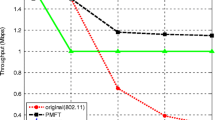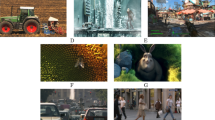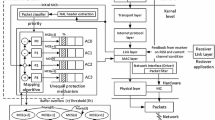Abstract.
Indiscriminated packet discards strongly degrade the quality perceived by end users of MPEG video transmissions. This paper investigates different Quality of Service (QoS) schemes and the tradeoffs of jointly adopting such schemes to improve the delivery quality of an MPEG stream. From an analytical model, we evaluate the impact of frame losses on the quality of MPEG streams and on the waste of network resources. Our assessment considers issues such as the use of redundancy by applying a Forward Error Correction (FEC) scheme to tolerate losses, the changing of the compression factor in MPEG encoding, the unequal protection of MPEG frames in a Differentiated Services environment, and how to evaluate the impact of network losses onto application quality. Results provide predicted bounds on the quality to be expected by end users as well as guidelines on how to take the best advantage from the joint adoption of the investigated QoS schemes.
Similar content being viewed by others
References
M.F. Alam, M. Atiquzzaman, and M.A. Karim:“Traffic shaping for MPEG video transmission over the next generation internet,” Computer Communications, Vol. 23, Nos. 14/15, pp. 1336–1348, 2000.
A. Albanese, J. Blömer, J. Edmonds, M. Luby, and M. Sudan,“Priority encoding transmission,” IEEE Transactions on Information Theory, Vol. 42, No. 6, pp. 1737–1744, 1996.
W. Ashmawi, R. Gu'erin, S. Wolf, and M. Pinson,“On the impact of policing and rate guarantees in diff-serv networks: A video streaming application perspective,” in Proc. of the ACM SIGCOMM’2001, San Diego, CA, USA, 2001.
S. Blake, D.L. Black, M. Carlson, E. Davies, Z. Wang, and W. Weiss,“An architecture for differentiated services,” RFC 2475, 1998.
J.M. Boyce and R.D. Gaglianello,“Packet loss effects on mpeg video sent over the public internet,” in Proc. of the ACM Multimedia 98, Bristol, England, 1998.
D.D. Clark, and W. Fang,“Explicit allocation of best effort packet delivery service,” IEEE/ACM Transactions on Networking, Vol. 6, No. 4, pp. 362–373, 1998.
L.H.M.K. Costa, S. Fdida, and O.C.M.B. Duarte,“Developing scalable protocols for three-metric QoS routing,” Computer Networks, Vol. 39, No. 6, pp. 713–727, 2002.
E. Crawley, R. Nair, B. Rajagopalan, and H. Sandick,“A framework for QoS-based routing in the internet,” RFC 2386, 1998.
R. Crooks,“An analysis of MPEG encoding techniques on picture quality,” White Paper–ektronix, 1998.
M.D. de Amorim, and O.C.M.B. Duarte,“A self-extracting accurate modeling for bounded-delay video services,” Computer Communications, Vol. 27, No. 3, pp. 197–207, 2004.
M.D. de Amorim, O.C.M.B. Duarte, and G. Pujolle,“Distinguishing video quality through differential matrices,” ACM Multimedia Systems Journal, Vol. 9, No. 1, pp. 94–103, 2003.
C. Diot, C. Huitema, and T. Turletti,“Multimedia applications should be adaptive,” in Proc. of the High Performance Computing Systems and Applications—HPCS’95, 1995.
K. Fall and K. Varadhan,“The ns manual,” UC Berkeley, LBL, USC/ISI, and Xerox PARC, 2002. Available at http://www.isi.edu/nsnam/ns/.
D. Farin, N. Mache, and P.H.N. de With,“SAMPEG: A scene adaptive parallel MPEG-2 software encoder,” in Proc. of the SPIE Visual Communications and Image Processing—VCIP’01, San Jose, CA, USA, 2001.
F.H.P. Fitzek and M. Reisslein,“MPEG-4 and H.263 video traces for network performance evaluation,” IEEE Network, Vol. 15, No. 6, pp. 40–54, 2001.
S. Floyd and V. Jacobson,“Random early detection gateways for congestion avoidance,” IEEE/ACM Transactions on Networking, Vol. 1, No. 4, pp. 397–413, 1993.
P. Frossard and O. Verscheure,“Joint source/FEC rate selection for quality-optimal MPEG-2 video delivery,” IEEE Transactions on Image Processing, Vol. 10, No. 12, pp. 1815–1825, 2001.
P.A.S. Gonçalves, J.F. de Rezende, O.C.M.B. Duarte, and G. Pujolle,“Optimal feedback for quality source-adaptive schemes in multicast multi-layered video environments,” IFIP Networking’2002, 2002.
K. Heidtmann, J. Kerse, T. Suchanek, B.E. Wolfinger, and M. Zaddach,“Fehlertolerante videokommunikation paketvermittlungsnetze,” in Proc. of the KiVS’2001, Springer-Verlag 2001.
J. Heinanen, F. Baker, W. Weiss, and J. Wroclawski,“Assured forwarding PHB group,” RFC 2597, 1999.
M. Hemy, U. Hengartner, P. Steenkiste, and T. Gross,“MPEG systems streams in best-effort networks,” in Proc. of the 9th Packet Video Workshop—PV’1999. New York, NY, USA, 1999.
R. Koenen,“MPEG-4: Multimedia for our time,” IEEE Spectrum, Vol. 36, No. 2, pp. 26–33, 1999.
M. Krunz,“Bandwidth allocation strategies for transporting variable-bit-rate video traffic,” IEEE Communications Magazine, Vol. 37, No. 1, pp. 40–46, 1999.
M. Krunz and S.K. Tripathi,“On the characterization of VBR MPEG streams,” in Proc. of the ACM SIGMETRICS’97. Seattle, WA, USA, 1997.
L. Mathy, C. Edwards, and D. Hutchison,“The internet: A global telecommunications solution?,” IEEE Network, Vol. 14, No. 4, pp. 46–57, 2000.
J. Shin, J. Kim, and C.-C.J. Kuo,“Quality of service mapping mechanism for packet video in differentiated services network,” IEEE Transactions on Multimedia, Vol. 3, No. 2, pp. 219–231, 2001a.
J. Shin, J.-W. Kim, and C.-C.J. Kuo,“Content-based packet video forwarding mechanism in differentiated services networks.” in Proc. of the 10th Packet Video Workshop—PV’2000, Cagliari, Italy, 2000.
J. Shin, J.-W. Kim, D.C. Lee, and C.-C.J. Kuo“Adaptive packet forwarding for relative differentiated service and categorized packet video,” in Proc. of the IEEE International Conference on Communications—ICC’2001, Helsinki, Finland, 2001b.
R. Storn,“Modeling and optimization of PET-redundancy assignment for MPEG sequences,” Technical Report TR-95-018, International Computer Science Institute, Berkeley, 1995.
D.S. Turaga and T. Chen,“Hierarchical modeling of variable bit rate video sources,” in Proc. of the 11th Packet Video Workshop—PV’2001, Kyongju, Korea, 2001.
O. Verscheure, X. Garcia, G. Karlsson, and J.-P. Hubaux,“User-oriented QoS in packet video delivery,” IEEE Network, Vol. 12, No. 6, pp. 12–21, 1998.
B.E. Wolfinger,“On the potential of FEC algorithms in building fault-tolerant distributed applications to support high QoS video communications,” in Proc. of the ACM Symp. on Principles of Distributed Computing—PODC’97, Santa Barbara, CA, USA, 1997.
B.E. Wolfinger and M. Zaddach,“Techniques to improve quality-of-service in video communications via best-effort networks,” in Proc. of the International Conference on Networking—ICN’2001., Colmar, France, 2001.
X. Xiao and L. Ni,“Internet QoS: the big Picture,” IEEE Network Vol.13, No. 2, pp. 1–13, 1999.
A. Ziviani, J.F. de Rezende, and O.C.M.B. Duarte,“Evaluating the expedited forwarding of voice traffic in a differentiated services network,” International Journal of Communication Systems, John Wiley and Sons, Vol. 15, No. 9, pp. 799–813, 2002a.
A. Ziviani, J.F. de Rezende, O.C.M.B. Duarte, and S. Fdida,“Evaluating voice traffic in a differentiated services environment,” in Proc. of the 17th International Teletraffic Congress—ITC17, Salvador, Brazil, 2001, pp. 907–918.
A. Ziviani, J.F. de Rezende, O.C.M.B. Duarte, and S. Fdida,“Improving the delivery quality of MPEG video streams by using differentiated services,” in Proc. of the European Conference on Multiservice Networks—ECUMN’2002, Colmar, France, 2002b, pp. 107–115.
A. Ziviani, B.E. Wolfinger, J.F. de Rezende, O.C.M.B. Duarte, and S. Fdida,“On the combined adoption of QoS schemes to improve the delivery quality of MPEG video streams,” in Proc. of the Intern. Symp. on Performance Evaluation of Computer and Telecommunications Systems—SPECTS’2002, San Diego, CA, USA,2002c, pp. 25–32.
Author information
Authors and Affiliations
Corresponding author
Additional information
Artur Ziviani received the B.Sc. degree in Electronics Engineering in 1998 and the M.Sc. degree in Electrical Engineering (with emphasis in Computer Networking) in 1999, both from the Federal University of Rio de Janeiro (UFRJ), Brazil. In December 2003, he received the Ph.D. degree in Computer Science from the University Pierre et Marie Curie (Paris 6), Paris, France, where he has also been a lecturer during the 2003–2004 academic year. Since September 2004, he is with the National Laboratory for Scientific Computing (LNCC), located in Petr'opolis, Brazil. His major research interests are quality of service, mobile and wireless computing, Internet measurements, and grid computing.
Bernd E. Wolfinger has been with the Computer Science Department of Hamburg University since 1981, where he is presently heading the Telecommunications and Computer Networks (TKRN) Subdivision. He has degrees from Universit Claude-Bernard, Lyon (Matrise, 74), University of Karlsruhe (Diploma, Mathematics 75; Ph.D., Comp. Sc. 79) and has spent long-term sabbaticals at IBM Research, Yorktown Heights, N.Y. (85), Internat. Computer Science Institute, Berkeley, Ca. (91,96), as well as at Universit P. et M. Curie, Paris (01). Dr. Wolfinger is active in Networking research since 1975, has been responsible for numerous conference organizations and has served on a variety of TPCs. He has been an editor of books and special issues of journals and has published more than 100 papers in areas such as High-speed & Mobile Networks, Real-time Communications, Traffic Engineering, Modeling, Performance Evaluation and QoS Management.
Jos'e Ferreira de Rezende received the B.Sc. and M.Sc. degrees in Electronic Engineering from the Universidade Federal do Rio de Janeiro (UFRJ) in 1988 and 1991, respectively. He received the Ph.D. degree in Computer Science from the Universit Pierre et Marie-Curie, Paris, France in 1997. He was an associate researcher at LIP6 (Laboratoire d’Informatique de Paris 6) during 1997. Since 1998 he is an Associate Professor at UFRJ. His research interests are in distributed multimedia applications, multipeer communication, performance evaluation and QoS aspects of high-speed, wireless and sensor networks.
Otto Carlos M.B. Duarte was born in Rio de Janeiro, Brazil, on October 23, 1953. He received the Electronic Engineer degree and the M.Sc. degree in Electrical Engineering from Universidade Federal do Rio de Janeiro, Brazil, in 1976 and 1981, respectively, and the Dr. Ing. degree from ENST/ Paris, France, in 1985. Since 1978 he is a Professor at Universidade Federal do Rio de Janeiro. From January 1992 to June 1993 he has worked at MASI Laboratory in Paris 6 University. In 1995, he has spent three months at International Computer Science Institute (ICSI) associated to the University of California at Berkeley. Presently, he is heading the computer network group (Grupo de Teleinformitica e Automao—GTA). His major research interests are in high speed communications, mobility, security and QoS guarantees.
Serge Fdida is a professor at the University Pierre et Marie Curie (Paris) since 1991. He received the Doctorat de 3eme Cycle in 1984, and the Habilitation a Diriger des Recherches specializing in Modelling of computer networks in 1989 from the University Pierre et Marie Curie. From 1989 to 1995, he was a Full Professor to the University Rene Descartes (Paris). His research interests are in the area of high speed networking, pervasive communication, resource management and performance analysis. He is heading the Network and Performance group of the LIP6 Laboratory (CNRS-University of Paris 6). He was a Visiting Scientist at IBM Research during the 1990/91 academic year. He was the chairman (or co-chair) of the following events: IFIP Modelling Techniques and Tools 87, IFIP High Performance Networking 94 (HPN 94), Performance of Data Communication 95 (PCN 95) and European Conference on Multimedia Applications, Services and Techniques 97 (ECMAST 97), Networked Group Communication (NGC 99) and IFIP Networking 2000. He was the editor of the proceedings of these conferences and is the author of a book on performance evaluation and a book on Networking. He is involved in many research projects in High Performance Networking in France and Europe. He was heading the RHDM Action in France for 8 years and the COST264 Action in Europe (98 02). He belongs to the FP6 network of Excellence ENEXT. He is a senior member of IEEE, a member of ACM and also involved in two IFIP working groups on networking. He is also the Co-Director of EURONETLAB, a joint laboratory established in 2001, between University Paris 6, CNRS, THALES and 6WIND, developing research and development work on QoS Routers and Radio Routers.
Rights and permissions
About this article
Cite this article
Ziviani, A., Wolfinger, B.E., de Rezende, J.F. et al. Joint Adoption of QoS Schemes for MPEG Streams. Multimed Tools Appl 26, 59–80 (2005). https://doi.org/10.1007/s11042-005-6849-4
Issue Date:
DOI: https://doi.org/10.1007/s11042-005-6849-4




